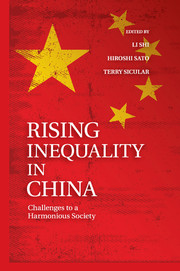Book contents
- Frontmatter
- Contents
- List of Tables
- List of Figures
- Contributors
- Preface
- Abbreviations
- Glossary
- 1 Rising Inequality in China
- 2 Overview
- 3 Housing Ownership, Incomes, and Inequality in China, 2002–2007
- 4 Educational Inequality in China
- 5 Inequality and Poverty in Rural China
- 6 The Evolution of the Migrant Labor Market in China, 2002–2007
- 7 A New Episode of Increased Urban Income Inequality in China
- 8 Unemployment and the Rising Number of Nonworkers in Urban China
- 9 Do Employees in the Public Sector Still Enjoy Earnings Advantages?
- 10 Redistributive Impacts of the Personal Income Tax in Urban China
- 11 Changes in the Gender-Wage Gap in Urban China, 1995–2007
- 12 Intertemporal Changes in Ethnic Urban Earnings Disparities in China
- Appendix I The 2007 Household Surveys
- Appendix II The 2002 and 2007 CHIP Surveys
- Index
- References
1 - Rising Inequality in China
Key Issues and Findings
Published online by Cambridge University Press: 05 July 2013
- Frontmatter
- Contents
- List of Tables
- List of Figures
- Contributors
- Preface
- Abbreviations
- Glossary
- 1 Rising Inequality in China
- 2 Overview
- 3 Housing Ownership, Incomes, and Inequality in China, 2002–2007
- 4 Educational Inequality in China
- 5 Inequality and Poverty in Rural China
- 6 The Evolution of the Migrant Labor Market in China, 2002–2007
- 7 A New Episode of Increased Urban Income Inequality in China
- 8 Unemployment and the Rising Number of Nonworkers in Urban China
- 9 Do Employees in the Public Sector Still Enjoy Earnings Advantages?
- 10 Redistributive Impacts of the Personal Income Tax in Urban China
- 11 Changes in the Gender-Wage Gap in Urban China, 1995–2007
- 12 Intertemporal Changes in Ethnic Urban Earnings Disparities in China
- Appendix I The 2007 Household Surveys
- Appendix II The 2002 and 2007 CHIP Surveys
- Index
- References
Summary
Introduction
More than three decades have passed since China embarked on economic reform and began to transform its economy from a socialist planned economy to a market economy. During these decades China has experienced rapid growth in gross domestic product (GDP) and personal living standards. Growth, however, has been accompanied by widening income inequality. The rise in inequality has been documented in a wide range of studies by individual researchers, international organizations, and government agencies (Benjamin et al. 2008; Griffin and Zhao 1993; Gustafsson, Li, and Sicular 2008; Ravallion and Chen 2007; Riskin, Zhao, and Li 2001; World Bank 2009; Zhang 2010). The various studies give different estimates of the level of inequality, but the authors all agree that since the 1980s inequality in China has increased markedly.
In the context of China's reforms and ensuing rapid growth, it is not surprising that inequality has increased. Growth is often associated with early stages of economic takeoff, which usually begin in particular sectors and regions. As those leading sectors and regions pull ahead of others, income distribution becomes increasingly uneven. Transition from a socialist planned economy characterized by egalitarian wage and income distribution systems also generates inequality. Markets bring income variation arising from risk and uncertainty, and they differentiate among households and individuals based on productivity, human capital, effort, entrepreneurship, and wealth holdings. In a market system, such sources of inequality can play a positive role in providing incentives for innovation, risk taking, effort, and investment.
- Type
- Chapter
- Information
- Rising Inequality in ChinaChallenges to a Harmonious Society, pp. 1 - 43Publisher: Cambridge University PressPrint publication year: 2013
References
- 15
- Cited by



